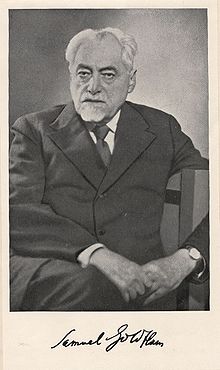Samuel Goldflam
| Samuel Goldflam | |
|---|---|
 |
|
| Born |
15 February 1852 Warsaw, Congress Poland |
| Died | 26 August 1932 (aged 80) Otwock, Poland |
| Occupation | Neurologist, best known for his brilliant 1893 analysis of myasthenia gravis (Erb-Goldflam syndrome). |
Samuel Wulfowicz Goldflam (15 February 1852 – 26 August 1932) was a Polish neurologist best known for his brilliant 1893 analysis of myasthenia gravis (Erb-Goldflam syndrome).
Goldflam received his education in his native city of Warsaw. He graduated from secondary school in 1869, then studied medicine at Warsaw University. He qualified as a physician in 1875, then worked in internal medicine at Holy Ghost Hospital under Professor Wilhelm Dusan Lambl (1824-95), known for the giardia parasite, Lamblia intestinalis. Lambl was not much of a mentor, so Goldflam worked largely by himself. His position at the internal-medicine clinic supplied him with ample research material. At that time, both internal-medicine and neurology patients were seen at Lambl’s clinic.
In 1882 Goldflam studied with the famous neurologists Karl Friedrich Otto Westphal (1833-90) and Jean-Martin Charcot (1825-93), then returned to Warsaw to teach neurology in the manner of the great masters. After a new period in Lambl’s clinic at Holy Ghost Hospital, he established his own clinic at Graniczna Street, no. 10, in Warsaw, for underprivileged patients, which he ran for nearly 40 years.
During World War I, Goldflam worked as a volunteer in the Jewish Hospital with his great friend, the neurologist, Edward Flatau (1869-1932). During the war he was one of the first to notice a correspondence between malnourishment and diseases, and he documented a bone and joint disease under the name osteoarthropathia dysalimentaria (1918). His main interest, however, was in the significance of reflexes, the neurological aspects of syphilis, and eye reflexes.
Goldflam was sharp clinician with ability to recognize small clues of illness which often escaped attention his colleagues. He not only worked with patients but was a pathologist. His profound observations and publications were recognized in Poland and abroad.
...
Wikipedia
